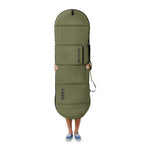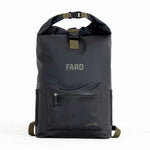Traveling with your surfboard can feel like an adventure on its own. Whether you’re heading out on a quick road trip to a local surf spot or flying halfway across the world to chase waves, protecting your surfboard during transport is critical. Surfboards are fragile, expensive, and vulnerable to dings, cracks, and pressure marks. That’s why knowing how to pack a surfboard bag correctly is a skill every surfer should master.
In this guide, we’ll walk you through different packing scenarios, the equipment you’ll need, and the step-by-step process of preparing your board, packing it, and securing it for travel. Along the way, we’ll share expert tips that will help you avoid damage and maximize protection—while keeping your trip stress-free.
Why Packing a Surfboard Bag Matters
Many surfers underestimate how much damage can happen to a board during transport. From roof racks and car vibrations to baggage handlers tossing bags at airports, your board is always at risk. A surfboard bag not only protects your board from external elements like sun, wind, and scratches but also ensures you can carry extra gear like wetsuits, towels, or surf accessories safely in one place.
At FARO, we design surfboard bags built for these exact situations. Our durable, padded, and eco-friendly bags are trusted by surfers worldwide to keep their boards safe during every kind of journey.
Different Packing Scenarios for Surfers
Packing a surfboard bag isn’t always the same—it depends on where and how you’re traveling. Below are the most common scenarios and how to approach them.
Short Road Trips
If you’re just heading down the coast for a few sessions, you don’t need heavy-duty packing. A lightweight day bag or a single board bag will be enough. Just make sure your surfboard is dry, and avoid stacking heavy objects on top of it in your car. Secure the bag with tie-down straps if it’s going on the roof rack.
Long Drives
For longer road trips, extra padding becomes important. Vibrations from hours of driving can wear down pressure points, especially along the rails. Add towels or bubble wrap to reduce rubbing inside the bag. Place wetsuits or soft gear around the board for additional cushioning.
Air Travel
Flying with a surfboard is where things get tricky. Airlines are known for being rough with oversized luggage, and surfboards are among the most vulnerable items. For this reason:
-
Use a durable travel surfboard bag with thick padding.
-
Always remove your fins and pack them separately.
-
Wrap the nose and tail of your surfboard with towels or foam blocks to absorb shocks.
-
Consider using clothes or wetsuits as extra padding—it saves luggage space while protecting your board.
-
Double-check airline surfboard baggage policies before heading to the airport.
If you’re flying often, FARO’s 7’ Travel Surfboard Bag is a trusted option. It offers extra-thick padding and compartments for additional gear.
Step 1: Gather All Necessary Packing Equipment
Before you start, make sure you have everything ready. Rushing the process or forgetting essentials is how boards get damaged. Here’s what you’ll need:
-
Surfboard Bag – Choose a well-padded bag that fits your board snugly.
-
Towels or Soft Clothes – Wrap around the nose and tail for cushioning.
-
Bubble Wrap or Foam Padding – Provides shock absorption.
-
Duct Tape – Keeps padding secure during travel.
-
Fin Key – Essential if you’re removing fins.
-
Wax Remover & Cloth – To clean off excess wax that might melt in transit.
-
Optional: Pool Noodles or Pipe Insulation – Cut them lengthwise and tape them along your board’s rails for next-level protection.

Step 2: Prepare the Surfboard for Packing
Your surfboard needs some prep before going into the bag. Here’s how to do it right:
Clean the Board
Remove any leftover wax. Not only can melted wax stick to bubble wrap or towels, but it can also leave messy stains inside your bag.
Remove the Fins
Whenever possible, take your fins off. They are prone to snapping or puncturing the bag if left on. Keep them wrapped in a small towel or fin pouch inside the bag.
Protect the Nose and Tail
These are the most vulnerable parts of a surfboard. Use towels, foam, or bubble wrap, then secure them with duct tape.
Pad the Rails
Rails take the brunt of side impacts. Wrapping them with bubble wrap or foam tubing adds another layer of security.
Step 3: Place the Surfboard in the Bag
Once your surfboard is prepped, it’s time to slide it into the bag properly.
-
Position the Board Carefully – Place it flat inside the bag with the nose toward the top.
-
Add Additional Padding – Stuff towels, wetsuits, or extra clothes around the board to prevent shifting.
-
Secure the Straps – If your bag has internal straps, tighten them to keep the board snug.
-
Avoid Overpacking – One mistake surfers make is shoving too much gear in one bag. This can stress the zippers and compress the board.
Step 4: Secure the Surfboard Bag
Your packing job isn’t complete until the bag is properly sealed and ready for transport.
-
Check Zippers – Ensure all zippers are fully closed. Consider taping them shut for air travel.
-
Seal with Duct Tape – Add extra tape around weak points if your trip will involve heavy handling.
-
Identification Tags – Always label your bag with your name, phone number, and destination. Lost luggage is stressful, but identification makes recovery easier.
-
Weigh the Bag – For flights, make sure your bag doesn’t exceed airline weight limits. Removing unnecessary gear can save you costly fees.
Pro Tips for Stress-Free Packing
-
Use Clothes as Padding – Double-duty packing saves luggage space.
-
Carry Essentials Separately – Keep your leash, wax, sunscreen, and personal items in a carry-on or backpack.
-
Document Your Board’s Condition – Take pictures of your board before travel in case you need to file an airline damage claim.
-
Invest in Quality Gear – A cheap bag may save money upfront but could cost you a board in the long run.

Common Mistakes to Avoid When Packing a Surfboard Bag
Even experienced surfers make errors when rushing to pack. Here are mistakes you can avoid:
-
Leaving fins on the board.
-
Not padding the nose, tail, or rails enough.
-
Overstuffing the surfboard bag with gear.
-
Forgetting to clean off melted wax.
-
Skipping ID tags or airline weight checks.
Conclusion
Packing a surfboard bag may take some time, but it’s well worth the effort. With the right preparation, you can protect your board against dings, cracks, and stress—even when traveling internationally. From short coastal trips to big surf expeditions abroad, your surfboard bag is your board’s first line of defense.
At FARO, we’ve designed surfboard bags specifically with travelers in mind. Our 7’ Travel Surfboard Bags and Day Bags are built with extra padding, eco-friendly materials, and smart features to give your surfboard the best protection possible. Whether you’re chasing waves locally or flying overseas, FARO gear makes the process easier and safer.
Ready to protect your board the right way?
Shop FARO Surfboard Bags
Frequently Asked Questions





